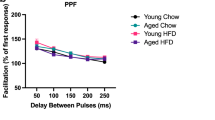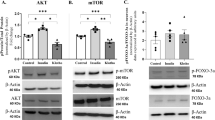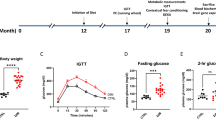Abstract
Increasing evidence indicates that circulating insulin-like growth factor I (IGF-I) acts as a peripheral neuroactive signal participating not only in protection against injury but also in normal brain function. Epidemiological studies in humans as well as recent evidence in experimental animals suggest that blood-borne IGF-I may be involved in cognitive performance. In agreement with observations in humans, we found that mice with low-serum IGF-I levels due to liver-specific targeted disruption of the IGF-I gene presented cognitive deficits, as evidenced by impaired performance in a hippocampal-dependent spatial-recognition task. Mice with serum IGF-I deficiency also have disrupted long-term potentiation (LTP) in the hippocampus, but not in cortex. Impaired hippocampal LTP was associated with a reduction in the density of glutamatergic boutons that led to an imbalance in the glutamatergic/GABAergic synapse ratio in this brain area. Behavioral and synaptic deficits were ameliorated in serum IGF-I-deficient mice by prolonged systemic administration of IGF-I that normalized the density of glutamatergic boutons in the hippocampus. Altogether these results indicate that liver-derived circulating IGF-I affects crucial aspects of mature brain function; that is, learning and synaptic plasticity, through its trophic effects on central glutamatergic synapses. Declining levels of serum IGF-I during aging may therefore contribute to age-associated cognitive loss.
This is a preview of subscription content, access via your institution
Access options
Subscribe to this journal
Receive 12 print issues and online access
$259.00 per year
only $21.58 per issue
Buy this article
- Purchase on Springer Link
- Instant access to full article PDF
Prices may be subject to local taxes which are calculated during checkout




Similar content being viewed by others
References
Torres-Aleman I . Serum growth factors and neuroprotective surveillance. Mol Neurobiol 2000; 21: 153–160.
D'Ercole AJ, Ye P, Calikoglu AS, Gutierrez-Ospina G . The role of the insulin-like growth factors in the central nervous system. Mol Neurobiol 1996; 13: 227–255.
Aleman A, Verhaar HJ, de Haan EH, de Vries WR, Samson MM, Drent ML et al. Insulin-like growth factor-I and cognitive function in healthy older men. J Clin Endocrinol Metab 1999; 84: 471–475.
Arwert LI, Deijen JB, Drent ML . The relation between insulin-like growth factor I levels and cognition in healthy elderly: a meta-analysis. Growth Horm IGF Res 2005; 15: 416–422.
Dik MG, Pluijm SM, Jonker C, Deeg DJ, Lomecky MZ, Lips P . Insulin-like growth factor I (IGF-I) and cognitive decline in older persons. Neurobiol Aging 2003; 24: 573–581.
Kalmijn S, Janssen JA, Pols HA, Lamberts SW, Breteler MM . A prospective study on circulating insulin-like growth factor I (IGF-I), IGF-binding proteins, and cognitive function in the elderly. J Clin Endocrinol Metab 2000; 85: 4551–4555.
Okereke O, Kang JH, Ma J, Hankinson SE, Pollak MN, Grodstein F . Plasma IGF-I levels and cognitive performance in older women. Neurobiol Aging 2007; 28: 135–142.
Rollero A, Murialdo G, Fonzi S, Garrone S, Gianelli MV, Gazzerro E et al. Relationship between cognitive function, growth hormone and insulin-like growth factor I plasma levels in aged subjects. Neuropsychobiology 1998; 38: 73–79.
Bulow B, Hagmar L, Orbaek P, Osterberg K, Erfurth EM . High incidence of mental disorders, reduced mental well-being and cognitive function in hypopituitary women with GH deficiency treated for pituitary disease. Clin Endocrinol (Oxf) 2002; 56: 183–193.
Lijffijt M, van Dam PS, Kenemans JL, Koppeschaar HP, de Vries WR, Drent ML et al. Somatotropic-axis deficiency affects brain substrates of selective attention in childhood-onset growth hormone deficient patients. Neurosci Lett 2003; 353: 123–126.
Markowska AL, Mooney M, Sonntag WE . Insulin-like growth factor-1 ameliorates age-related behavioral deficits. Neuroscience 1998; 87: 559–569.
Trejo JL, Carro E, Lopez-Lopez C, Torres-Aleman I . Role of serum insulin-like growth factor I in mammalian brain aging. Growth Horm IGF Res 2004; 14(Suppl A): 39–43.
Lupien SB, Bluhm EJ, Ishii DN . Systemic insulin-like growth factor-I administration prevents cognitive impairment in diabetic rats, and brain IGF regulates learning/memory in normal adult rats. J Neurosci Res 2003; 74: 512–523.
Castro-Alamancos MA, Torres-Aleman I . Learning of the conditioned eye-blink response is impaired by an antisense insulin-like growth factor I oligonucleotide. Proc Natl Acad Sci USA 1994; 91: 10203–10207.
Svensson J, Diez M, Engel J, Wass C, Tivesten A, Jansson JO et al. Endocrine, liver-derived IGF-I is of importance for spatial learning and memory in old mice. J Endocrinol 2006; 189: 617–662.
Carro E, Torres-Aleman I . Serum insulin-like growth factor I in brain function. Keio J Med 2006; 55: 59–63.
Fratiglioni L, Paillard-Borg S, Winblad B . An active and socially integrated lifestyle in late life might protect against dementia. Lancet Neurol 2004; 3: 343–353.
Carro E, Trejo JL, Busiguina S, Torres-Aleman I . Circulating insulin-like growth factor I mediates the protective effects of physical exercise against brain insults of different etiology and anatomy. J Neurosci 2001; 21: 5678–5684.
Yakar S, Liu JL, Stannard B, Butler A, Accili D, Sauer B et al. Normal growth and development in the absence of hepatic insulin-like growth factor I. Proc Natl Acad Sci USA 1999; 96: 7324–7329.
Sjogren K, Liu JL, Blad K, Skrtic S, Vidal O, Wallenius V et al. Liver-derived insulin-like growth factor I (IGF-I) is the principal source of IGF-I in blood but is not required for postnatal body growth in mice. Proc Natl Acad Sci USA 1999; 96: 7088–7092.
Carro E, Trejo JL, Gomez-Isla T, LeRoith D, Torres-Aleman I . Serum insulin-like growth factor I regulates brain amyloid-beta levels. Nat Med 2002; 8: 1390–1397.
Crawley JN, Belknap JK, Collins A, Crabbe JC, Frankel W, Henderson N et al. Behavioral phenotypes of inbred mouse strains: implications and recommendations for molecular studies. Psychopharmacology (Berl) 1997; 132: 107–124.
Carrascosa C, Torres-Aleman I, Lopez-Lopez C, Carro E, Espejo L, Torrado S et al. Microspheres containing insulin-like growth factor I for treatment of chronic neurodegeneration. Biomaterials 2004; 25: 707–714.
Morris R . Developments of a water-maze procedure for studying spatial learning in the rat. J Neurosci Methods 1984; 11: 47–60.
Carro E, Spuch C, Trejo JL, Antequera D, Torres-Aleman I . Choroid plexus megalin is involved in neuroprotection by serum insulin-like growth factor I. J Neurosci 2005; 25: 10884–10893.
Fernandez AM, de la Vega AG, Torres-Aleman I . Insulin-like growth factor I restores motor coordination in a rat model of cerebellar ataxia. Proc Natl Acad Sci USA 1998; 95: 1253–1258.
Myhrer T, Johannesen TS . Learning and retention of a visual discrimination task in rats with various combinations of lesions in the temporal-hippocampal region. Brain Res Bull 1995; 36: 499–503.
Paxinos G, Watson CR . The Rat Brain in Stereotaxic Coordinates. Academic Press: Sydney, 1982.
Alonso-Nanclares L, De Felipe J . Vesicular glutamate transporter 1 immunostaining in the normal and epileptic human cerebral cortex. Neuroscience 2005; 134: 59–68.
Cossart R, Dinocourt C, Hirsch JC, Merchan-Perez A, De Felipe J, Ben Ari Y et al. Dendritic but not somatic GABAergic inhibition is decreased in experimental epilepsy. Nat Neurosci 2001; 4: 52–62.
Kleschevnikov AM, Belichenko PV, Villar AJ, Epstein CJ, Malenka RC, Mobley WC . Hippocampal long-term potentiation suppressed by increased inhibition in the Ts65Dn mouse, a genetic model of Down syndrome. J Neurosci 2004; 24: 8153–8160.
Fernandez AM, Gonzalez de la Vega AG, Planas B, Torres-Aleman I . Neuroprotective actions of peripherally administered insulin-like growth factor I in the injured olivo-cerebellar pathway. Eur J Neurosci 1999; 11: 2019–2030.
Pulford BE, Whalen LR, Ishii DN . Peripherally administered insulin-like growth factor-I preserves hindlimb reflex and spinal cord noradrenergic circuitry following a central nervous system lesion in rats. Exp Neurol 1999; 159: 114–123.
Carro E, Nunez A, Busiguina S, Torres-Aleman I . Circulating insulin-like growth factor I mediates effects of exercise on the brain. J Neurosci 2000; 20: 2926–2933.
Nunez A, Carro E, Torres-Aleman I . Insulin-like growth factor I modifies electrophysiological properties of rat brain stem neurons. J Neurophysiol 2003; 89: 3008–3017.
Lopez-Lopez C, LeRoith D, Torres-Aleman I . Insulin-like growth factor I is required for vessel remodeling in the adult brain. Proc Natl Acad Sci USA 2004; 101: 9833–9838.
Aberg MA, Aberg ND, Hedbacker H, Oscarsson J, Eriksson PS . Peripheral infusion of IGF-I selectively induces neurogenesis in the adult rat hippocampus. J Neurosci 2000; 20: 2896–2903.
Trejo JL, Carro E, Torres-Aleman I . Circulating insulin-like growth factor I mediates exercise-induced increases in the number of new neurons in the adult hippocampus. J Neurosci 2001; 21: 1628–1634.
Carroll RC, Beattie EC, von Zastrow M, Malenka RC . Role of AMPA receptor endocytosis in synaptic plasticity. Nat Rev Neurosci 2001; 2: 315–324.
Gonzalez de la Vega V, Buno W, Pons S, Garcia-Calderat MS, Garcia-Galloway E, Torres-Aleman I . Modulatory effects of insulin-like growth factor I on cerebellar glutamate receptors. October, New Orleans, USA. 1998. Society for Neuroscience: New Orleans, 1998, pp 1784.
Gonzalez de la Vega AV, Buno W, Pons S, Garcia-Calderat MS, Garcia-Galloway E, Torres-Aleman I . Insulin-like growth factor I potentiates kainate receptors through a phosphatidylinositol 3-kinase dependent pathway. NeuroReport 2001; 12: 1293–1296.
Man YH, Lin JW, Ju WH, Ahmadian G, Liu L, Becker LE et al. Regulation of AMPA receptor-mediated synaptic transmission by clathrin-dependent receptor internalization. Neuron 2000; 25: 649–662.
Ramsey MM, Adams MM, Ariwodola OJ, Sonntag WE, Weiner JL . Functional characterization of des-IGF-1 action at excitatory synapses in the CA1 region of rat hippocampus. J Neurophysiol 2005; 94: 247–254.
Skeberdis VA, Lan J, Zheng X, Zukin RS, Bennett MV . Insulin promotes rapid delivery of N-methyl-D-aspartate receptors to the cell surface by exocytosis. Proc Natl Acad Sci USA 2001; 98: 3561–3566.
Wang YT, Linden DJ . Expression of cerebellar long-term depression requires postsynaptic clathrin-mediated endocytosis. Neuron 2000; 25: 635–647.
Blair LA, Marshall J . IGF-1 modulates N and L calcium channels in a PI 3-kinase-dependent manner. Neuron 1997; 19: 421–429.
Kanzaki M, Zhang YQ, Mashima H, Li L, Shibata H, Kojima I . Translocation of a calcium-permeable cation channel induced by insulin-like growth factor-I. Nat Cell Biol 1999; 1: 165–170.
Torres-Aleman I, Pons S, Arevalo MA . The insulin-like growth factor I system in the rat cerebellum: developmental regulation and role in neuronal survival and differentiation. J Neurosci Res 1994; 39: 117–126.
Sonntag WE, Bennett SA, Khan AS, Thornton PL, Xu X, Ingram RL et al. Age and insulin-like growth factor-1 modulate N-methyl-D-aspartate receptor subtype expression in rats. Brain Res Bull 2000; 51: 331–338.
Zona C, Ciotti MT, Calissano P . Human recombinant IGF-I induces the functional expression of AMPA/kainate receptors in cerebellar granule cells. Neurosci Lett 1995; 186: 75–78.
Kamenetz F, Tomita T, Hsieh H, Seabrook G, Borchelt D, Iwatsubo T et al. APP processing and synaptic function. Neuron 2003; 37: 925–937.
Snyder EM, Nong Y, Almeida CG, Paul S, Moran T, Choi EY et al. Regulation of NMDA receptor trafficking by amyloid-beta. Nat Neurosci 2005; 8: 1051–1058.
Barnes CA, Rao G, Houston FP . LTP induction threshold change in old rats at the perforant path–granule cell synapse. Neurobiol Aging 2000; 21: 613–620.
Breese CR, Ingram RL, Sonntag WE . Influence of age and long-term dietary restriction on plasma insulin-like growth factor-1 (IGF-1), IGF-1 gene expression, and IGF-1 binding proteins. J Gerontol 1991; 46: B180–B187.
Lee HK, Min SS, Gallagher M, Kirkwood A . NMDA receptor-independent long-term depression correlates with successful aging in rats. Nat Neurosci 2005; 8: 1657–1659.
Yakar S, Liu JL, Fernandez AM, Wu Y, Schally AV, Frystyk J et al. Liver-specific igf-1 gene deletion leads to muscle insulin insensitivity. Diabetes 2001; 50: 1110–1118.
Craft S, Watson GS . Insulin and neurodegenerative disease: shared and specific mechanisms. Lancet Neurol 2004; 3: 169–178.
Donahue CP, Kosik KS, Shors TJ . Growth hormone is produced within the hippocampus where it responds to age, sex, and stress. Proc Natl Acad Sci USA 2006; 103: 6031–6036.
Dunger D, Yuen K, Ong K . Insulin-like growth factor I and impaired glucose tolerance. Horm Res 2004; 62(Suppl 1): 101–107.
Biessels GJ, Kamal A, Urban IJ, Spruijt BM, Erkelens DW, Gispen WH . Water maze learning and hippocampal synaptic plasticity in streptozotocin-diabetic rats: effects of insulin treatment. Brain Res 1998; 800: 125–135.
Nguyen PV, Abel T, Kandel ER, Bourtchouladze R . Strain-dependent differences in LTP and hippocampus-dependent memory in inbred mice. Learn Mem 2000; 7: 170–179.
Pollak DD, Scharl T, Leisch F, Herkner K, Villar SR, Hoeger H et al. Strain-dependent regulation of plasticity-related proteins in the mouse hippocampus. Behav Brain Res 2005; 165: 240–246.
Koopmans GC, Brans M, Gomez-Pinilla F, Duis S, Gispen WH, Torres-Aleman I et al. Circulating insulin-like growth factor I and functional recovery from spinal cord injury under enriched housing conditions. Eur J Neurosci 2006; 23: 1035–1046.
Ding Q, Vaynman S, Akhavan M, Ying Z, Gomez-Pinilla F . Insulin-like growth factor i interfaces with brain-derived neurotrophic factor-mediated synaptic plasticity to modulate aspects of exercise-induced cognitive function. Neuroscience 2006; 140: 823–833.
Acknowledgements
We thank Dr J de Felipe (Cajal Institute) for his advice with synaptic markers, Dr MA Arevalo for his help with the pPCR and Dr J Torrado (Universidad Complutense, Madrid) for his generous help with IGF-I microspheres. We also appreciate the invaluable help of J Sancho, I Alvarez and M Garcia. This work was supported by Grants SAF2001-1722 and 2004-0446.
Author information
Authors and Affiliations
Corresponding author
Additional information
Supplementary Information accompanies the paper on the Molecular Psychiatry website (http://www.nature.com/mp)
Supplementary information
Rights and permissions
About this article
Cite this article
Trejo, J., Piriz, J., Llorens-Martin, M. et al. Central actions of liver-derived insulin-like growth factor I underlying its pro-cognitive effects. Mol Psychiatry 12, 1118–1128 (2007). https://doi.org/10.1038/sj.mp.4002076
Received:
Revised:
Accepted:
Published:
Issue Date:
DOI: https://doi.org/10.1038/sj.mp.4002076
Keywords
This article is cited by
-
Identification of the molecular mechanism of insulin-like growth factor-1 (IGF-1): a promising therapeutic target for neurodegenerative diseases associated with metabolic syndrome
Cell & Bioscience (2023)
-
The neurobiology of insulin-like growth factor I: From neuroprotection to modulation of brain states
Molecular Psychiatry (2023)
-
Insulin-like growth factor I mitigates post-traumatic stress by inhibiting AMP-kinase in orexin neurons
Molecular Psychiatry (2022)
-
Neural correlates of beneficial effects of young plasma treatment in aged mice: PET-SPM analyses and neuro-behavioural/molecular biological studies
European Journal of Nuclear Medicine and Molecular Imaging (2022)
-
Endothelial deficiency of insulin-like growth factor-1 receptor (IGF1R) impairs neurovascular coupling responses in mice, mimicking aspects of the brain aging phenotype
GeroScience (2021)



